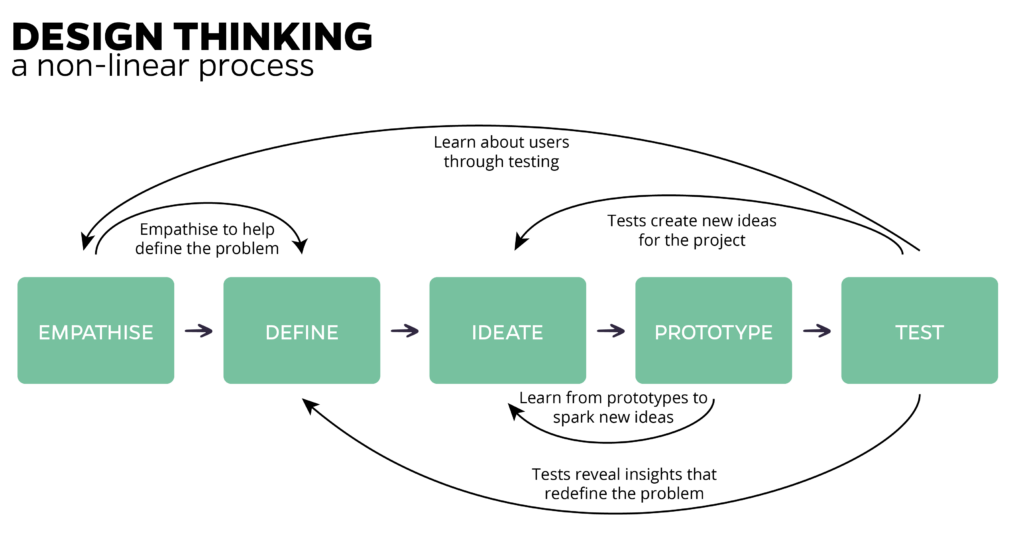In the article ‘What’s your problem’ you were able to read what user research is and why it is important to dive deeper into the emotions and behavior of your target group in order to really offer what they need. And not what you think they need. In this article, we take a closer look at the five steps of design thinking. How do you go from a real business problem to a real (IT) solution?
Design thinking method
There are several methods to apply design thinking to business challenges. At LINKIT we use the following five steps:

Looking for the unknown
Design thinking is an iterative process. As you can see, designers use the results to improve their previous findings and assumptions continuously so that the final result will too. In addition, it is also a problem-solving method in which you test what is known and look for factors that are uncertain or unknown. By going through them one by one you will find out how they blend into each other.
1. Empathize – With your users
Empathy means that you try to empathize as much as possible with the emotions, needs, motivations and ‘drivers’ of behavior of your target group. The corona crisis and the associated measures are a perfect example of this. The moment people no longer see the coronavirus as the problem, but the actions taken against it change, their emotions, needs, motivation and behavior change. And that affects the effectiveness of the measures.
2. Define – Your users’ needs, their problems and your insights
The trick is then to map this out correctly. As a result, you will come to a much better and, therefore, more acceptable solution. User research (LINK) is extremely important for this. The essence is that the focus is on the problem and not on the solution. Users can be inside or outside your organization.
3. Ideate – Dare to examine your assumptions and create ideas for innovative solutions critically.
User research seldom immediately provides a complete picture of your target group’s needs, problems, and behavior. Certainly not when it comes to a large external group, in which many different factors play a role. Ideation is about coming up with solutions. The core of this is looking for inspiration outside your bubble, thinking associatively and trying to solve the problem from different perspectives. Then you critically examine them together.
To come back to corona: the fact that groups of people mainly regard measures as a problem does not mean that you should abolish them. More factors, such as full hospitals, may not be so important to them, but they are to the government. The trick is then to find a solution that satisfies both as much as possible.
In a company’s practice, this friction is sometimes present. The course that the top of a company wants to set does not always match the needs of the employees on the floor. That in itself is not a bad thing, as long as you are willing to delve into that need and adapt the solution accordingly. Design thinking helps you with that.
4. Prototype – Start working out your solution
Manufacturers of just about anything will never let a product roll off the assembly line without first building a prototype. You may have thought out something so perfectly, but in practice there is always something wrong with it. You really learn by simply putting it into practice. Then you see what happens and how your users interact with and respond to it. This provides valuable input to improve your solution or even come up with a completely different product or service.
5. Test – the solution in practice
Testing does not stop the moment you launch your (IT) solution. User needs are not set in stone. They keep changing. By checking from time to time whether your solution is still the real solution to the real problem, you can make timely adjustments and expand your product or service with features that add real value.
Do you want to know more about design thinking? Or do you want to apply it in practice? LINKIT’s UX designers can help you further. Contact them for more information.

